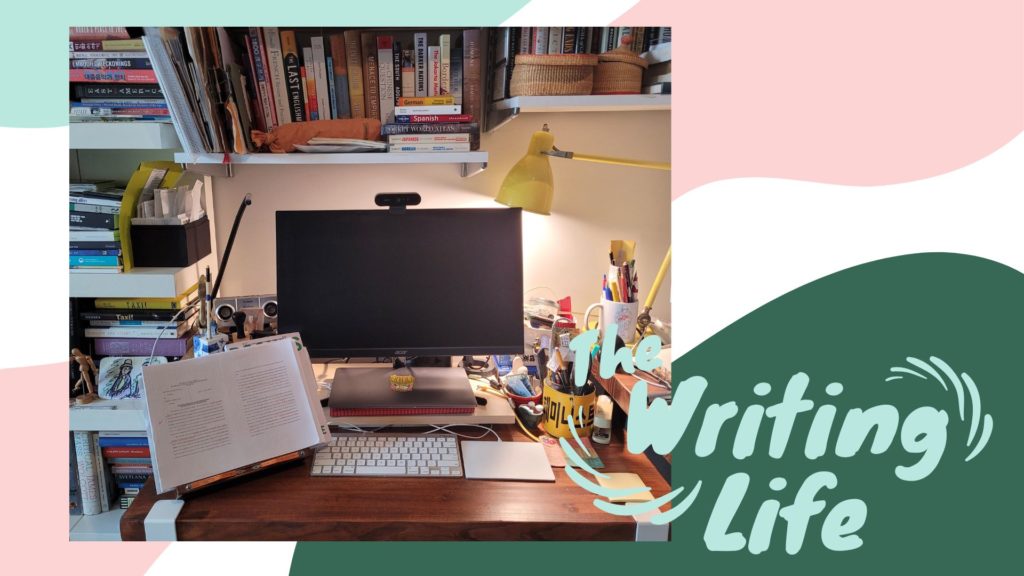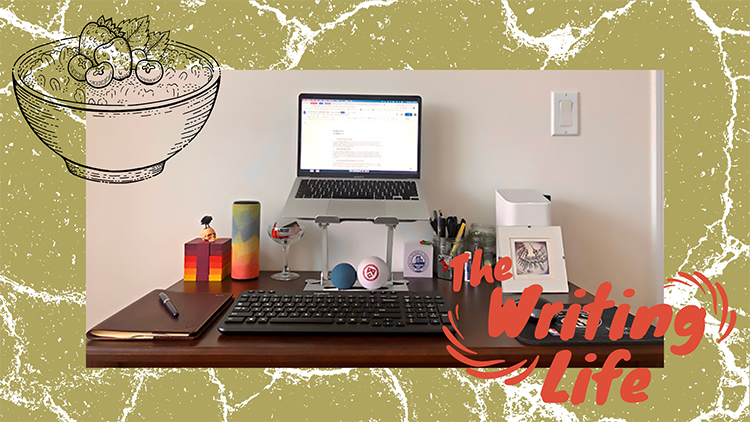Former Open City Fellow Nadia Misir answers thirteen questions about her writing life
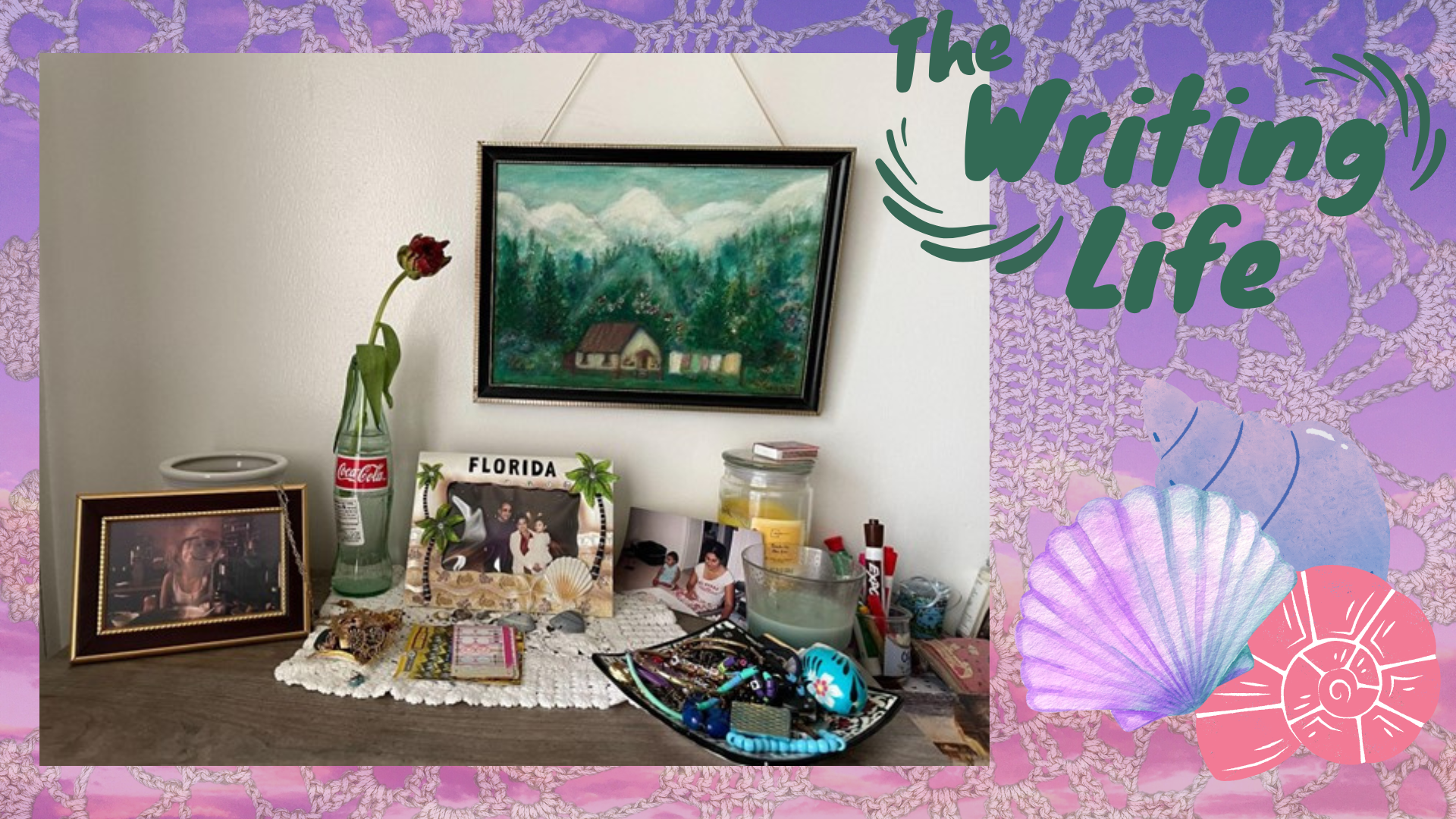
November 17, 2022
“Writing is easy,” Pulitzer Prize–winning sportswriter Red Smith once said. “All you do is sit down at a typewriter and open your veins, and bleed.” Putting pen to paper (or fingers to a keyboard) is never a simple task, even for seasoned writers. Even our Margins and Open City Fellows—and there’s quite a handful of them—can attest to that. Many of them, though, have gone on to write and report for mainstream publications and publish books. In this series, we reached out to our former fellows and asked them to give us a glimpse of their writing lives and to share some tips on how they navigate this creative process called writing.
Nadia Misir is a 2015 Open City Fellow. In “To Eat, Drink, and Gyaff,” she ventured into the many roti shops just steps from the A train in Richmond Hill, comfort places where Indo-Guyanese can engage in dhalpuri and gyaffing. Nadia explored the Guyanese’s love for vintage American country-western music that helps Indo-Guyanese express ineffable heartbreak, spirituality, and political emergence in “Guyana ♥ Country.”
In 2016, Nadia and Fellowship batchmate Sonny Singh, motivated by curiosity and a chance to savor authentic tea, teamed up to find out how South Asian and Indo-Caribbean immigrants prepare their respective teas and joined them at tea time in “We Talkin’ About ‘Back Home.’” She wrote about how Richmond Hill’s residents are opposing a city’s effort to build a youth offenders center in the neighborhood in “Too Close to Home.”
Here’s Nadia.
—Noel Pangilinan
1. What’s on your nightstand?
Too many things! A photograph of my maternal grandparents and me as a toddler at JFK airport. I don’t know if they were departing or arriving.
There’s another framed, underexposed photograph of me at 99 Favor Taste on Grand Street. I can’t remember if it was my birthday or the birthday of my ex-boyfriend and now friend, Angel, but I do remember walking down to the East River that day with him and watching people fish by the piers. It was spring—cold enough for a jacket, warm enough for it to be left unzipped. This is one of my favorite photos because the colors are muted and earthy. It’s more shadow than light. I look at it and remember the smoky scent of meats and vegetables being barbecued.
The last photo is unframed and shows my mom about a year or two after giving birth to my kid sister Anjali. Her rolls of baby fat are my favorite part of the photo.
The rest: a white crocheted doily, a yellow candle that says “Soak Up the Sun,” a jewelry holder I made out of clay and painted, a jewelry holder I bought in Istanbul, a Sheffield lock back folding knife, a lottery scratch my mom gave me a few weeks ago, two Vivi’s Bubble Tea reward cards, and some smooth seashells from different beaches. The gray-blue and white shells remind me of stormy skies.
Hanging above all this beloved clutter is a painting by my great-aunt Pearly. When she migrated to London in her seventies, she taught herself how to paint by watching television programs. Her daughter, my Aunty Dolly, gifted it to me on a recent visit to London. The more I learn about how creative the women in my family were, the more confidence I have to keep writing.
This painting shows a cottage and clothing hung up to dry on a line in the yard. There are trees and mountains in the background, flowers and grass. It looks like it’s raining. I love this painting for its jewel blues and greens, for the soft brushstrokes that remind me of the way a fogged-up bus window blurs the streets outside when it rains.
Finally, there’s a deep red carrot tulip from Ica Sadagat’s Language Aquatics course standing elegant and tall in an empty Coke bottle with water. Language Aquatics was unlike any other writing course I’ve taken. We made time to stretch and dangle, to breathe, to read out loud from texts like Audre Lorde’s “A Litany for Survival” while walking around our quiet room with the large windows at the LGBT Center on 13th Street, and to reckon with questions Ica asked like: What is the place of heart work in our writing and creative practice? What practices can counter the training of non-loving language-making?
Language Aquatics for me was about tapping into my body and senses to make sense of and enjoy language. Ica’s course has been lifeblood for reviving my creative practice in a way that centers my body, my needs, tenderness, care, collaboration, and relationships with people I love and people who love me. I look at it and am grateful for how Ica has tended to each of us each Sunday, providing us with both sensory and literary nourishment, with a space to deeply feel, and for me, to unlearn the ways I locate my sense of self-worth and validation in my degrees and academia.
2. If you had a superpower, what would it be? Why?
If I had a superpower, I would create fire using my hands. I would reheat all of my drinks and food. I can be notoriously slow at consuming anything, which is a problem because I like my food burn-the-roof-of-your-mouth hot. I would use my powers to warm the hands of my loved ones when they are cold and melt things like surveillance cameras and OMNY machines. If I could have another superpower, I would harness my tears.
3. What’s a typical day for you?
A typical day starts with me lying in bed while checking astrology Twitter and the bus schedule and MTA website for any travel alerts. My commute to work is usually at least an hour and a half to two hours long. After burning my eyeballs with my phone screen, I take a hot shower and listen to Mariah Carey’s “Breakdown.” If my sister is still sleeping, I’ll go into her room and tousle her hair until she wakes up. Fortunately, my parents have been working from home since the pandemic started so after bothering my sister, I make my rounds with them.
I’ll toast plait bread on the tawa and eat that with cheese for breakfast. I take two buses and a train to get to the school I work at in the Lower East Side. The Q37 route at this time of year is beautiful. I stare out of the window and appreciate the golden and burgundy leaves on the trees. I work as an activity specialist in an afterschool program with kindergarteners and first graders, so the day goes by quickly once I’m at work. We usually have snack time and different activities planned for the kids. I leave feeling bone-tired, but many things about working with kids bring me joy.
When I left a different school I worked at, one of my fourth-grade kiddos gave me a handmade book about what she loved about after school. It’s one of the most touching gifts I’ve received from a person. Last week, we made paper-plate monsters and read a picture book about monsters going on vacation.
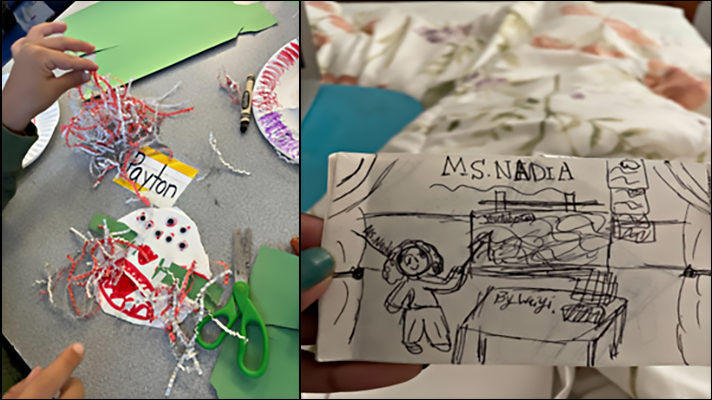
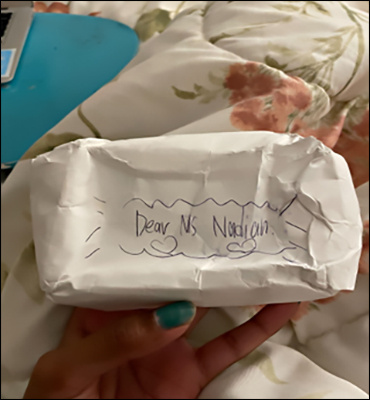
4. Coffee or tea? Why?
I take both with a socially unacceptable amount of scalded whole milk and a spoon of Demerara sugar. Lately I’ve been heating up milk and mixing in a spoon of instant coffee and sugar. I learned that this is the best nightcap for me from my Aunty Dolly when my mom and I recently visited her in London. I love tea too! I just tend to switch between the two every couple of months or so. If I’m ever in Jackson Heights, I get a chai or Kashmiri chai from Al-Naimat. For a long time that was my nightly routine and treat after my evening classes as an MFA student.
5. Any book you’re reading now?
I just finished The Crying Book by Heather Christle. I love that her meditations on crying are loose and fleeting. I just started Thin Places: A Natural History of Healing and Home
by Kerri ní Dochartaigh. Her descriptions of Northern Ireland’s eerie, beautiful landscapes and the violence of The Troubles is helping me think through my own relationship to Guyana’s lush greenery, and legacy of racial and political violence. What do the land and water witness? I always reread Shivanee Ramlochan’s searing and fierce collection of poems, Everyone Knows I Am a Haunting, during spooky season. Her poem “Catching Devi and Shakuntala” is the poem I want to live in, the poem I wish was written when I was a teen. I hold these lines close to my heart:
Be the daughter that rises from her,
shortskirted and fullflamed
improbable and darkskinned
like wet mango leaves slick with puja oil in yourpalms.
On that recent trip to London, my Aunty Dolly gave me a book of poetry her brother self-published. It’s titled Anthrophanies 1. Nightwinds and was printed in London in 1972. He was diagnosed with schizophrenia later in his life. I don’t understand all of the poems, but I can feel the deep and chaotic emotions that drive each one. Aunty Dolly spoke to my mom and I a lot about madness and heartbreak, about the way both of these things have touched the people in our lineage.
My favorite lines:
Who pulses to the thrum of wind
beating my heart with violent wings
trips from cloud of grass to bone of sky
wild winds pass.
6. What book made you cry?
Tanaïs’s In Sensorium made me bawl on the A train. It kept me company on my commutes to work this past summer as a camp counselor. The days were long and grueling. I’d be up at either 5 a.m. or 6 a.m. to get to work on time and not get home until 8 p.m. This book held me tightly and carved out space for me to cry. For years I’ve tried to articulate what intimacy in all of its forms has taught me about the politics of identity, power, and love in the South Asian diaspora—Tanaïs’s writing gently nudged me to return to that desire to write about love without shame, without feeling self-conscious about coming off as frivolous; to write for people I love and who love me.
Some other books that made me cry from summer to now are Terese Marie Mailhot’s Heart Berries, Kiese Laymon’s Heavy, Fariha Róisín’s Who Is Wellness For? An Examination of Wellness Culture and Who It Leaves Behind, and Alexis Pauline Gumbs’s Undrowned: Black Feminist Lessons from Marine Mammals.
7. When do you write best—morning, afternoon, or at night?
Usually between 11 p.m. and 3 a.m., when our home is quiet and everyone is sleeping, when the sounds outside my window are planes en route for JFK, cars drag racing on the Belt or doing burnouts in some lot nearby. I prefer to write under the cloak of night because I write best while having and after a good cry.
8. Do you have a writing ritual?
It changes with each season. Right now, I’m trying to find my way back to my writing practice. I’m realizing my work as a writer is deeply connected to the relationships I build and nourish with the people around me. I have a tendency to ghost and disappear from people in my life. I’m trying really hard to understand why this happens and how to change it.
This season my ritual has included making time for friends who have shown me deep care and love despite my tendency to isolate. Hookah sessions with my brilliant poet-friends Will and M.A. Pindling; healing dinners with Natasha, Tori, and Victoria; getting too lit too quick off of bellinis with my cousin Priya; sangria smoothies and Japanese BBQ at Gyu-Kaku with Angel; finding my way back to nourishing, creative spaces like Ica’s Language Aquatics; using Instagram like Tumblr in the early 2000s and posting caption-poem-reflections that are too long.
I try to use the Notes app on my phone to keep track of ideas while I’m out and about. When I sit down to write at my desk, I stretch; light a candle; speak to my ancestors, especially my maternal grandparents; and play music that soothes me. My sister is also a big part of my writing practice even though she’s twelve years younger. We always make time to catch up on each other’s days. Our favorite restaurant to catch up at is Bonchon on 23rd Street. We always get takoyaki as a starter. She’s a visual artist and poet, so I love talking to her about her process.
9. How do you deal with writer’s block?
I try to listen to my body and stop writing. I wait. Sometimes for months or years. I try to rest. I do something else. I remind myself that I am more than my writing. I cook and chop up garlic. I make a cherry tomato vodka sauce from scratch because pasta is one of my comfort foods. I learn to knit and choose the softest yarn. I don’t expect to knit a scarf or a sweater. I just knit rows, just focus on moving my hands. On counting. I paint. I focus again on my hands moving, on the magical satisfaction of brush strokes. I walk to the East River and study the currents. I think about words like estuary and why we have so many words to describe different bodies of water.
10. How and where do you get ideas for your stories?
My mom will say something that sounds sweet to my ears or recount a memory that leaves an impression on me. She will tell me that my great-grandmother sewed rice bags together to make bedsheets. Or she will tell me she learned to make gulgula when her father told her his mother would make it every year for Diwali. Each year he told her it tasted better and better. What a beautiful act of love it is to try to recreate the taste of something your loved one thought was gone forever.
Or I will be driving along the Belt Parkway with someone close to my heart. The windows will be down, and we’ll pull into a parking lot behind a motel and Comfort Inn in Sheepshead Bay and walk underneath the glow of the full moon towards people fishing where water meets the shore.
Or somebody dies, and my pen will help me wade through the grief that rises like a river current up to my chest.
Or I will confuse any touch as a tender touch and cry, and the page will wait for me.
Or I will gaze in awe at old family photographs of my grandma and Aunty Dolly: brazen, free, confident in their posture, staring coolly back at the camera.
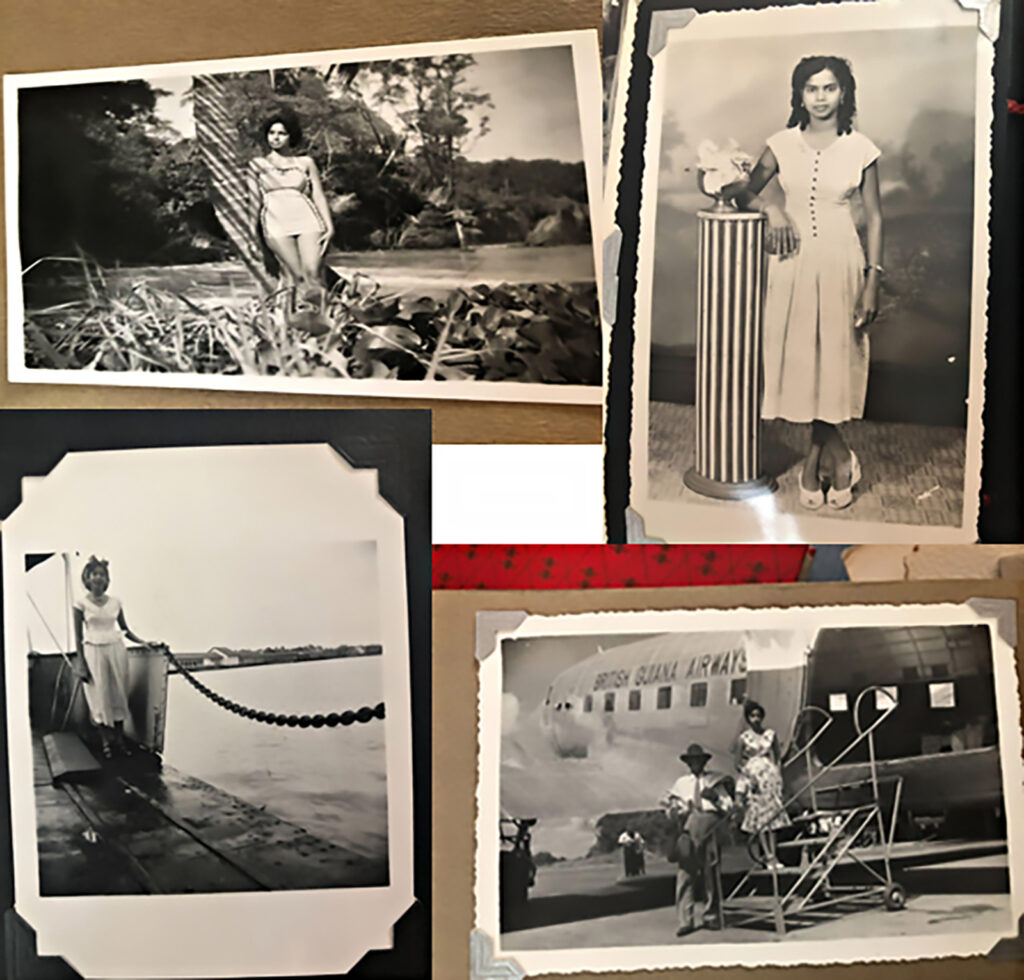
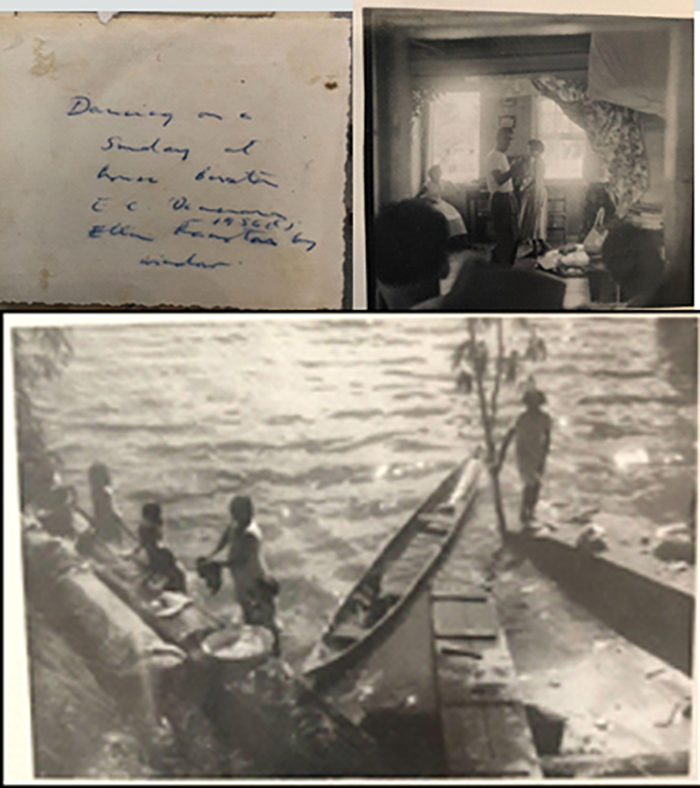
11. Do you have any tips for interviewing people?
Compensate people for their time, labor, and the vulnerability it takes to open up to someone.
Understand what your intentions are behind interviewing someone and what the impact of sharing their story will be for them, their loved ones, their community, you and your community, your readers. Be transparent with people about these intentions, about how their stories will be used.
Remind yourself that everyone has a voice. Many times, it is better to leverage your power and privilege to clear space for someone to tell their own story instead of doing it yourself.
12. What are you working on now, and what recent work are you proud of?
I’m working on a young adult novel about a Guyanese-American girl who learns to street race so she can beat her rich ex-boyfriend at a car meet in an act of revenge. She ends up falling for another racer and learning lots about who she is and how she loves and wants to be loved.
I’m most proud of a recent caption reflection I posted on Instagram in response to a Costar message that said “Stop pining” despite it being Scorpio season. When I read it, I can feel that I’m learning to discern between healthy and unhealthy intimacy, relationships and attachments. It felt healing to write it, and it feels healing to read it.
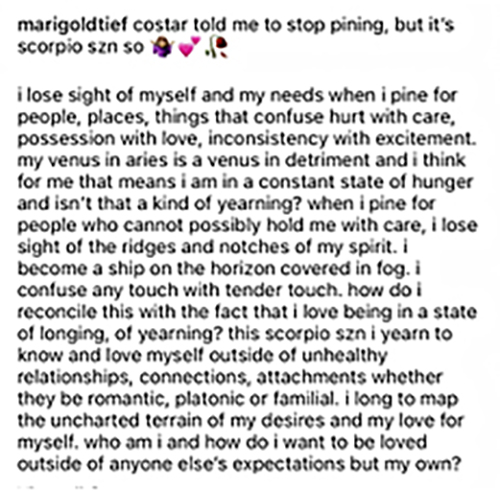
13. What’s your fondest memory of being an AAWW Fellow?
Our days walking through different neighborhoods together, particularly the days we explored Kensington with Chaya Babu and Richmond Hill with Sonny Singh, both amazing fellows from my cohort. In Richmond Hill we drank cha at a gurdwara and went into a pooja shop where someone was selling cricket bats and playing country-western songs. It surprised many in our group and led to my first piece for the fellowship: “Guyana <3 Country.” There was also a DJ playing chutney music at the opening of a Dunkin’ Donuts on the Avenue. I’m writing this on October 26, 2022, exactly eight years after that day in Richmond Hill.
Other stories in The Writing Life series:
“Every Piece of Writing Should Express or Represent” by Mohamad Saleh
“When You’re Interviewing, You’re the One in Charge” by Eveline Chao
“Just Listen, Really Listen” By Roja Heydarpour
“No Other Way to Be a Writer Except to Be Alone in a Room” by Anelise Chen
That Which You Are Afraid to Write, Write It” by huiying b. chan
“Cut Down the Quotes . . . Include Only Gemlike Phrases” by E. Tammy Kim
“I Am Still Developing as a Writer” by Hannah Bae
“Write a Sentence—Any Sentence—No Matter How Bad It Is” by Astha Rajvanshi
“Intuition Is My Main Tool” by Chaya Babu
“Writer’s Block? What’s That?” by Humera Afridi

